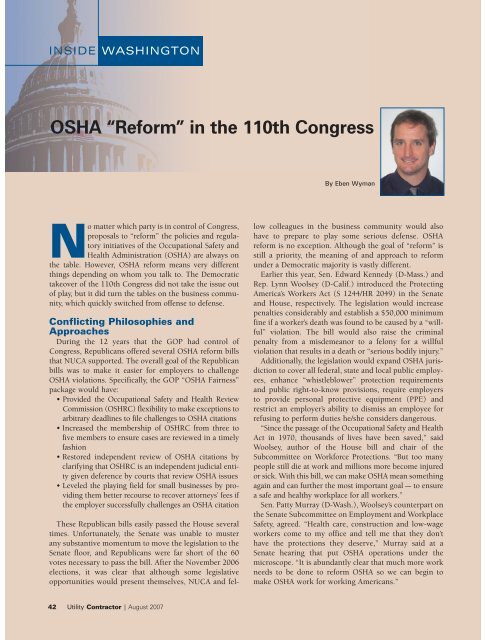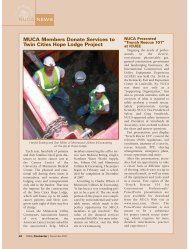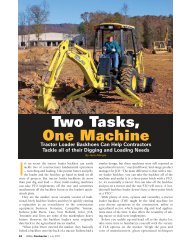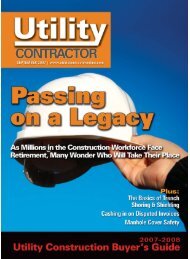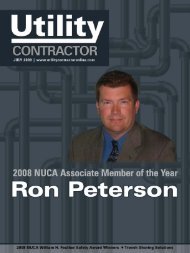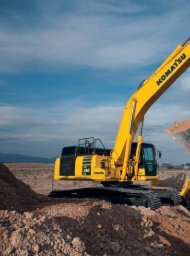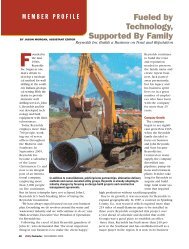View Full August PDF Issue - Utility Contractor Online
View Full August PDF Issue - Utility Contractor Online
View Full August PDF Issue - Utility Contractor Online
- No tags were found...
Create successful ePaper yourself
Turn your PDF publications into a flip-book with our unique Google optimized e-Paper software.
INSIDE WASHINGTONOSHA “Reform” in the 110th CongressBy Eben WymanNo matter which party is in control of Congress,proposals to “reform” the policies and regulatoryinitiatives of the Occupational Safety andHealth Administration (OSHA) are always onthe table. However, OSHA reform means very differentthings depending on whom you talk to. The Democratictakeover of the 110th Congress did not take the issue outof play, but it did turn the tables on the business community,which quickly switched from offense to defense.Conflicting Philosophies andApproachesDuring the 12 years that the GOP had control ofCongress, Republicans offered several OSHA reform billsthat NUCA supported. The overall goal of the Republicanbills was to make it easier for employers to challengeOSHA violations. Specifically, the GOP “OSHA Fairness”package would have:• Provided the Occupational Safety and Health ReviewCommission (OSHRC) flexibility to make exceptions toarbitrary deadlines to file challenges to OSHA citations• Increased the membership of OSHRC from three tofive members to ensure cases are reviewed in a timelyfashion• Restored independent review of OSHA citations byclarifying that OSHRC is an independent judicial entitygiven deference by courts that review OSHA issues• Leveled the playing field for small businesses by providingthem better recourse to recover attorneys’ fees ifthe employer successfully challenges an OSHA citationThese Republican bills easily passed the House severaltimes. Unfortunately, the Senate was unable to musterany substantive momentum to move the legislation to theSenate floor, and Republicans were far short of the 60votes necessary to pass the bill. After the November 2006elections, it was clear that although some legislativeopportunities would present themselves, NUCA and fellowcolleagues in the business community would alsohave to prepare to play some serious defense. OSHAreform is no exception. Although the goal of “reform” isstill a priority, the meaning of and approach to reformunder a Democratic majority is vastly different.Earlier this year, Sen. Edward Kennedy (D-Mass.) andRep. Lynn Woolsey (D-Calif.) introduced the ProtectingAmerica’s Workers Act (S 1244/HR 2049) in the Senateand House, respectively. The legislation would increasepenalties considerably and establish a $50,000 minimumfine if a worker’s death was found to be caused by a “willful”violation. The bill would also raise the criminalpenalty from a misdemeanor to a felony for a willfulviolation that results in a death or “serious bodily injury.”Additionally, the legislation would expand OSHA jurisdictionto cover all federal, state and local public employees,enhance “whistleblower” protection requirementsand public right-to-know provisions, require employersto provide personal protective equipment (PPE) andrestrict an employer’s ability to dismiss an employee forrefusing to perform duties he/she considers dangerous.“Since the passage of the Occupational Safety and HealthAct in 1970, thousands of lives have been saved,” saidWoolsey, author of the House bill and chair of theSubcommittee on Workforce Protections. “But too manypeople still die at work and millions more become injuredor sick. With this bill, we can make OSHA mean somethingagain and can further the most important goal — to ensurea safe and healthy workplace for all workers.”Sen. Patty Murray (D-Wash.), Woolsey’s counterpart onthe Senate Subcommittee on Employment and WorkplaceSafety, agreed. “Health care, construction and low-wageworkers come to my office and tell me that they don’thave the protections they deserve,” Murray said at aSenate hearing that put OSHA operations under themicroscope. “It is abundantly clear that much more workneeds to be done to reform OSHA so we can begin tomake OSHA work for working Americans.”42 <strong>Utility</strong> <strong>Contractor</strong> | <strong>August</strong> 2007


